Hearing about an alternative to pumpkin borekas used to fulfill the simanim of squash for the Rosh Hashanah dinner blessings (Yehi Ratzones), I endeavored to find a picture or recipe. I have no memory of my mom or Nona making these. I am not sure which Sephardic people made these or what towns they came from. They sounded so intriguing, a coil like a boyu filled with pumpkin and dairy-free. I found a picture on the internet and so an idea formed in my head. This is what I made. If any of you have a good recipe or some pointers on how to do this, or remember your Nona’s making this dish, please contact me.
Serves 8 to 16 (cut in half)
Dough:
3 cups of all purpose unbleached flour, plus ¼ quarter cup for kneading
½ teaspoon salt
1 cup warm water
4 tablespoons sunflower oil
1 teaspoon apple cider vinegar
Additional flour for dusting
Filling:
20 ounces
1/3 cup brown sugar
1/ 2 teaspoon cinnamon
Cinnamon sugar made with 3 tablespoons granulated sugar and 1 tablespoon cinnamon placed in a spice bottle with a shaker top.
1/ 2 cup sunflower oil
1/3 cup sesame seeds
 Place flour and salt in mixing bowl of a stand mixer. Add warm water with oil, and vinegar to flour. Beat until a ball of dough forms, about one minute. Let the dough rest for 10 minutes. Touch the dough to determine how sticky it is. Add remaining 1/ 4 cup flour and beat dough until soft, smooth, shiny, and easily removable from mixing bowl. Place the smooth dough ball in a medium oiled bowl and cover with a tea towel to rest for about one hour. This dough does not rise.
Place flour and salt in mixing bowl of a stand mixer. Add warm water with oil, and vinegar to flour. Beat until a ball of dough forms, about one minute. Let the dough rest for 10 minutes. Touch the dough to determine how sticky it is. Add remaining 1/ 4 cup flour and beat dough until soft, smooth, shiny, and easily removable from mixing bowl. Place the smooth dough ball in a medium oiled bowl and cover with a tea towel to rest for about one hour. This dough does not rise.
During the resting time, prepare a table for stretching dough and filling it. For stretching, I recommend a kitchen table covered with a clean white bed sheet dusted in flour. Combine pumpkin, brown sugar, and cinnamon in a medium bowl, stir to mix ingredients and set aside for a moment.
Pre-heat oven to 375° F. Remove dough from the bowl where it has been resting. Place it in the center of the floured sheet on the table. Give dough a couple of passes with a wood rolling pin to make a rectangle, and then start to stretch by hand. Before stretching, remove all jewelry. Next, close your hands into a fist and with the knuckle-side up; slide your hands under the dough. Use the tops of your hands and move them methodically around the perimeter to expand the dough. The dough will stretch easily. Carefully work your way around forming a rectangle. Then go deeper toward the center, ever expanding. Work slowly and methodically, don’t rush dough. Continue stretching until dough is about a 32 inch by 40 inch rectangle. Use a scissor to trim the tiny thick edge that is left on the perimeter. Brush dough very lightly with sunflower oil using a pastry brush. I recommend a silicone brush to prevent any tearing. Sprinkle dough with a bit of cinnamon sugar.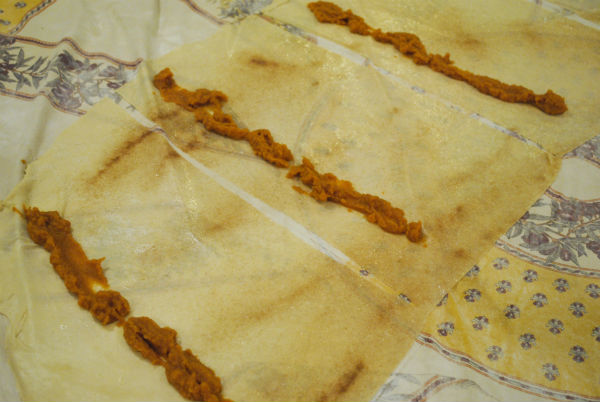
With a sharp knife, divide dough into 8 rectangles. Place a line of filling down the long side of the rectangle about 1 1/ 2 inches from the edge of one side. Distribute filling among rectangles. Start rolling coils by pulling narrow edge over the filling and then pushing the cylinder into a roll, like rolling up a carpet. Seal the two ends and coil the cylinder.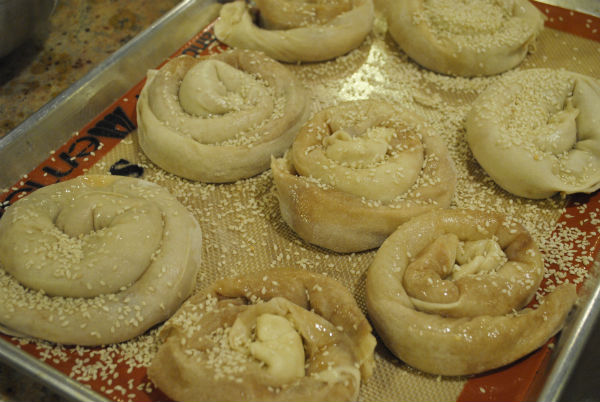
Place each roll on a silpat or parchment paper baking sheet. Brush Rodanchas with oil, using a pastry brush and sprinkle with sesame seeds. Bake until golden in color, about 30 minutes. Serve warm and crisp. Rodanchas may be frozen and reheated.
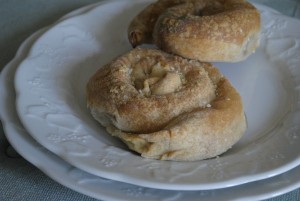
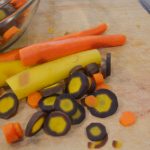
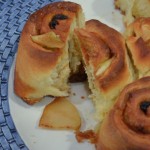
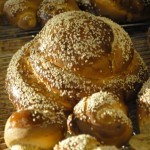
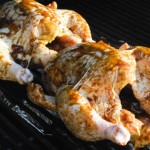
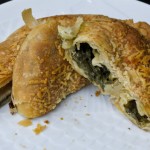
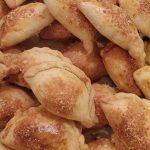
It is a common pastry in the Greek Sephardic community. Mostly you watch until the pumpkin mixture gets fairly thick. I have seen these wrapped in phyllo dough instead…like a tiropita.
Hello!
I am dating a greek Jew at the moment and got these as a special request for rosh hashanah–I have a book called the cookbook of the Jews of Greece and they have a bunch of different fillings for the coils which are called “Rodanchas.”
I was looking to see if I could find pictures to get an idea of how to make them and came across your recipe.
Above you said you didn’t know, so hopefully this was helpful 🙂 shanah tova!
My Nona was a Greek Romaniote; my grandpa was a Turkish Sephardic. She made them for him. They believed their origin was Edirne (Turkey), and she filled them with a mixture of cheese and squeezed spinach. In today’s time we would get a box of frozen chopped spinach, put it in a strainer to thaw, and then squeeze the living daylights out of it.
Hi Lynda, look on the site for other recipes, boyus or bulemas for the spinach and cheese variety. I use fresh spinach,or beet greens or rainbow swiss chard or any combination of them. I buy the pre washed baby spinach to mix with the cheese and it is much dryer and easier to work with.